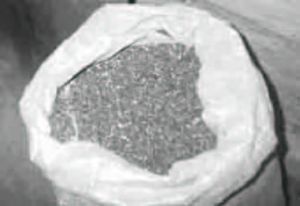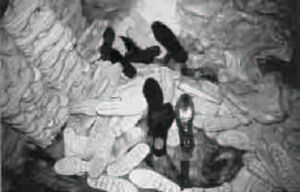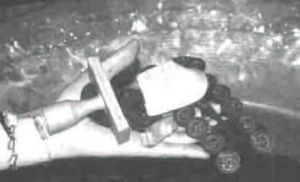In many developing countries, the recycling of plastic waste is an economically profitable activity. The cheap labour costs can limit the cost of treatment and thus compete with the price of virgin resins, the latter being generally expensive because they are imported. Moreover, in these countries, the demand for products made of plastic is increasing, which offers an increasingly larger waste deposit and a potential market for recycled materials. Nevertheless, the economic viability of any recycling project depends on many factors which if they are not sufficiently controlled, may compromise the activity. Thus, we can not overemphasize the importance of market opportunities. These must be analyzed in the evaluation phase of a project. They are indeed the only financial income of a recycling center. The taking over of markets and their sustainability is crucial. The following paragraphs detail some economic aspects to consider to ensure the economic viability of a recycling center.
Costs of recycling[edit | edit source]
The costs for the recycling of waste plastics can be divided in three categories: the purchase of the plastic waste, investment and production costs.
The purchase of plastics[edit | edit source]
The purchase price of waste plastics depends on their type and quality. When the recycling center itself hires collection agents, they can generally collect the industrial, commercial and agricultural waste for free. Instead, municipal waste brought in by the population and those brought in from sorting centres or those sorted at the landfill must be purchased by weight. Their price is usually between 5 and 15% of the prices for virgin resin. Their quality is variable, however, so it is often necessary to establish price lists according to certain criteria. In India, there are two major categories, namely waste collected at the source (slightly soiled), and waste collected in landfills (soiled). Their prices vary widely: 3% and 16% respectively of the price of virgin resins. These price differences are clearly related to the costs of treatment (washing) that the soiling causes, but also because the weight of the dirt is also included in the price of the plastic, thus it must be removed!
This division can also be done in a larger number of categories where the prices can be clearly shown. The collection agents and the receptionists of the recycling center have a critical role which consistcs of properly assessing the quality of the brought-in plastics. In addition, they must take note of the amount of purchased waste for each category and note down its weight in a an account book. It goes without saying that we should not buy plastics that the center is not capable of recycling. A minimum of vigilance is necessary during the purchase because when it is done and they were paid for nothing, the waste will unnecessarily clutter the center. The purchase of plastic waste requires cash money. Experience shows that some artisans working in recycling (sorters, washers, ...) have seen their business limited by a lack of cash money which is needed for the supply of waste plastics. A study in India showed that 25% of business failures in plastics recycling was due to liquidity problems.
Investment costs[edit | edit source]
Investment costs primarily include the purchase (or lease) of land, buildings and equipment. These costs are fixed, regardless of the quantity of the recycled plastics. The land must be able to accommodate a large stock of waste. In addition, activities as sorting, washing and drying are generally carried out outdoors (sometimes in a roofed yard). Buildings must have a sufficient size so as to house the machines and some kind of office also needs to be present. Although the cost of land and real estate is easy to assess, the amount of investments in machinery is less obvious to assess (see chapter 4 and 5). Machines such as extruders and injection presses generally don't survive much longer than 5 to 7 years, so they are pushed (often two posts of 8 hours with little maintenance). It is therefore necessary to include provisions for their replacement.
Treatment costs[edit | edit source]
By treatment costs we mean the costs associated with production, namely: manpower, consumables (water, electricity, detergents, additives, ...), and transport. These vary with the amount of plastics recycled by the recycling center. For most existing centers, it is between 200 and 600 kg/day. The principal treatment cost is the labor cost. Recycling plastic is indeed an activity that requires significant human capital. For this we must hire a staff that provides accounting, waste reception, the overall management of the center and the sale of the processed products. When we know the labour costs of the local workforce, it is possible to evaluate the necessary personnel costs for the proper functioning of the recycling center in advance, and then adjust them in the process. As a reminder, the capacity of a person for the various treatment phases are given in table 6.1.
| Operations | Daily production per person | Remarks |
|---|---|---|
| Collection | 10-50 kg | Depending on the type of established collection system. |
| Sorting | 80-150 kg | Depending on the experience of the sorters. |
| Washing -drying | 50-100 kg | Depending on the degree of soiling and the type of washing. |
| Grinding | 300-2000 kg | Depending on the capacity of the used machine (1 to 2 people per machine including one qualified person) |
| Melting | 20 kg -> | According to the capacity of the used machine (2 people per machine, including one qualified) |
| Shaping | 2 kg -> | According to the capacity of the used machine (1 person per machine trained
on its use) |
Table 6.1: Human capital necessary for recycling plastic waste
Transport costs are also an important part of the treatment costs. The various remarks given in chapter 3 are worth being carefully considered: adequate transport facilities, central location, transfer sites, size reduction of the waste to obtain greater densities in bulk, ... The cost of consumables can be calculated from a quick survey of the different prices that are used locally. For certain products used in large quantities, such as detergents, soda, and possibly pigments and other chemical additives, it may be useful to research the possibility of importing large quantities. The prices are often cheaper. For the various mechanical devices, do not forget to take maintenance hours and costs.
On a whole, it is not easy to calculate the production costs in advance, as these vary depending on the local conditions. In addition, recycling centers rarely go through the trouble of calculating the data and few data is available anyhow. The following table nonetheless provides a breakdown of the treatment costs for three recycling centers:
| Type | Breakdown of treatment costs | ||
|---|---|---|---|
| Istanbul(Source: Waste) | Cameroon (Source: CIPRE) | Kinshasa[1](source: ISF-IAI) | |
| Labor | 31% | 68% | 32% |
| Transport | 22% | 12% | 5% |
| Consumables | 18% | 12% | 21% |
| Rooms | 7% | 10% | |
| Investments | 9% | 28% | |
| Others | 13% | 8% | 5% |
Table 6.2: Breakdown of treatment costs
The high variation in investment costs is due to the fact that only the project in Kinshasa included a complete recycling approach (up to melting) where the other two are limited to grinding.
Opportunities[edit | edit source]
The market opportunities are essential in plastic waste recycling projects. Indeed, they represent the only financial income at the end of the treatment process.
Inventory of possible market opportunities[edit | edit source]
Each processing step provides added value to products, and depending on the case, a possible market opportunity.
a. Reuse Reuse is perhaps one of the noblest ways to recycle waste. It gives a new life to the product after a possible refurbishing step. This can be done for a range of products. In Yaounde for example, 30% of the collected shoes are washed and refurbished and then sold at one third of the price of new sandals.
b. The sorted-washed-dried plastics In countries where the recycling of plastic waste is well introduced (Egypt, India, Turkey, ...), the sorting, washing and drying is done by small companies which are specialised in this step. Batches of plastic thus made are sold to other companies specialized in grinding, melting and/or shaping.
c. The flakes The pre-cutting and grinding of the plastic flakes gives a added value that become lucrative when there are large shaping factories in the vicinity of the center. Indeed, they generally have the disposition of recycling extruders for the recycling of their own plastic waste.

They are often interested in introducing a part of the sorted and washed plastic waste flakes (5 to 20%) to reduce the manufacturing costs. Others produce objects that are entirely based on recycled plastic for lower quality markets. A complete inventory of companies working in the vicinity of the center should be made up during the evaluation phase of the project.
d. The granules The pellet market is quite similar to that of flakes, except that the demanded prices may be higher. Indeed, the processors only have to do the granulating themselves before using them. The granulation step offers the possibility to provide products with the characteristics required by the shaping enterprises. In India, the "pellets" are produced at the request of consumers according to a list of provided features. These pellets have the required properties: color, physical properties (plasticizing agents, antioxidants, stabilizers, ...), costs, quality (mixed with virgin resin), ...
e. Shaped products Generally, all manufactured products based on virgin resins can be achieved with recycled materials. However, some markets must be avoided: medical objects, food packaging, objects that may be placed in the mouth, ... It is not possible to compile a comprehensive inventory of all market opportunities. The following list may however provide some ideas:
| Plastics | Objects |
|---|---|
| HDPE/LDPE | bottles, toys, flower pots, circulation cones, baskets, containers, household objects, irrigation pipes, bags, sheets, screw plugs, combs, pipes, tampons, cloth hangers, spectacle frames, joints, ... |
| PP | household objects, suitcases, wire coils, tools, ... |
| PVC | electrical pipes, drainage and irrigation pipes, bottles, cables, rigid pipes, soles, sandals, ... |
| PS | toys, shoe heels, lamp fixtures, electrical equipment, ... |
Table 6.3: Non-comprehensive list of potential opportunities
Objects made with small injection plunger presses (see chapter 5) are generally limited to fifty grams.

Economically, the production of finished products should be taken with caution. Bad choices can have disastrous consequences. Molds and dies are very expensive. It is necessary to ensure that there is a lareg enough market to can buy the products we can produce.

Sale of recycled plastics[edit | edit source]
The selling price of recycled plastics depends directly on the virgin resins on the local market. This is directly related to the current global market price of the resins (itself dependent on oil prices). The following table shows the evolution of the prices of different polymers:
| Price of polymers (€/kg) | ||||
|---|---|---|---|---|
| Year | PE | PP | PS | PVC |
| 1997 | 0.77 | 0.77 | 0.66 | |
| 1998 | 0.84 | 0.84 | 0.75 | |
| 1999 | 0.61 | 0.54 | 0.66 | 0.53 |
| 2000 | 0.97 | 0.80 | 0.92 | 0.82 |
| 2001 | 0.96 | 0.89 | 1.15 | 0.78 |
| 2002 | 0.65 | 0.69 | 0.75 | 0.56 |
| 2003 | 0.90 | 0.85 | 1.20 | 0.81 |
Table 6.4: Evolution of virgin resin prices
Onto this we must add the import costs: transport, customs, taxes, ... In some countries, prices have increased by 20 to 50%. Moreover, the delay of delivery is often significant which can encourage processors to buy recycled plastics. Before approaching them, it is thus useful to know the local resin market price in order to allow negotiating the price correctly. Experience shows that the price can be resold at each treatment stage in following orders of magnitude:
| Features | Price[2] | Remarks |
|---|---|---|
| Collected plastics | 5 to 15% | Depending on the type, quality, degree of soiling, ... |
| Sorted plastics | 10 to 25% | Depending on the fractions and their quality. |
| Washed-dried plastics | 25-50% | Depending on their cleanliness (washing type). |
| Cut plastics | 25-50% | Does not offer any great added value, but reduces the treatment costs. |
| Flakes | 40-65% | Depending on the type of plastic, color and cleanliness. |
| Pellets | 55-80% | Depending on the quality and additives (pigments, plasticizers, fillers, ...) |
| Recycled objects | > 100% | These can achieve very large prices (competition with virgin resin objects market). |
Table 6.5: Values of plastics at the various stages of recycling
These prices can vary significantly from one local situation to another. The table below shows the selling prices for some reference cities:
| Charisteristics | Price (Kinshasa, DR Congo) | Price (Istanbul, Turkey) | Price (Yaounde, Cameroon) | Price (Bangalore, India) | Price (Nouakchott, Mauritania) | |
|---|---|---|---|---|---|---|
| Collected plastics | 5% | 11.6% | 4-16% | 3-16% | ||
| Sorted plastics | 11% | 18.6% | ||||
| Washed plastics | 29-33% | 46.5% | 16-33% | 26-37% | ||
| Flakes | 37-49% | 62.8% | ||||
| Pellets | 58-67% | 74.4% | 74-80% | 70% |
Table 6.6: Variation in plastic prices for different countries Note: All prices are expressed as a percentage of the virgin resin value.
This data allow us to place the recycling of waste plastics in an economic context. Any project initiator should estimate the costs and markets for his own situation to assess the viability of his activity.
